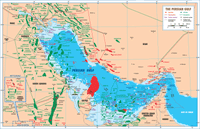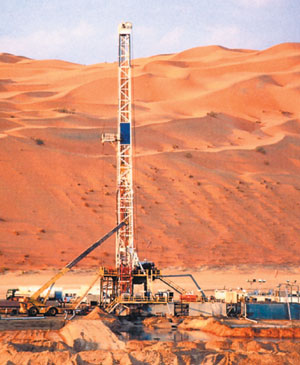|
Aug.
2001 Vol. 222 No. 8
International Outlook
|
MIDDLE EAST
Investment levels rise higher
A multitude of upstream projects continues throughout the region, and
natural gas is playing a greater role in many domestic plans. Saudi Arabia’s recent award of three major
gas development projects is a good example
Dr. A. F. Alhajji, Contributing Editor,
Boulder, Colorado
Saudi Arabia
Rising population, greater energy demand and high
unemployment forced Saudi Arabia to open its gas sector to foreign investment. After more than two years of
negotiations, proposals and investment law reform, eight international oil companies (IOCs) were short-listed
on May 18 to invest $25 billion in non-associated gas projects. The projects cover 176,000 sq mi (440,000 sq
km) in three "Core Venture" areas.
 |
|
|
ExxonMobil Corp. (35%) will lead Core Venture 1 in the
north Rub’ al-Khali, with Royal Dutch / Shell (25%), BP (25%) and Phillips Petroleum (15%) as partners.
This venture – the biggest on offer – is viewed as a $15-billion development. ExxonMobil (70%) will
also lead Core Venture 2 on the Red Sea, with Marathon and Occidental Petroleum Corp. holding stakes (15%,
each). This $4-billion project includes the construction of gas processing plants in the northwestern Maidyan
and Barqan fields. The venture also includes exploration in onshore / offshore Blocks 40 – 49, which
extend from north to south along the Red Sea coast.
Royal Dutch / Shell (30%) will lead Core Venture 3,
developing the Shaybah gas project in north Rub’ al-Khali, with TotalFinaElf and Conoco (30%, each). The
$4-billion project should make the companies a return on investment of between 10% and 15%.
Exploration. Aramco announced a sweet gas /
condensate find in the Eastern Province late in 2000. Almazlij 24 tested gas in the "Unayzah Reservoir."
It is to the east of Mazalij oil field, 17 mi (28 km) north of Ghazal gas field, 53 mi (85 km) west of Haradh
and 81 mi (130 km) southeast of Riyadh.
New tests on Ghazal 1 (discovered in July 2000) boosted
its capability to 40 MMcfgd and 5,400 bcpd, more than twice the original estimate. This was the latest in a
string of commercial gas strikes in the southern Ghawar region that resulted from an intensive exploration
campaign begun in 1994. Aramco has a 25-year gas program that has set aside $45 billion to build a large gas
processing plant every five years.
Recent comments by officials indicate that the Kingdom
replenished produced oil reserves and may have added 3 billion bbl, thus maintaining proven reserves of 263
billion bbl.
Drilling / development. Greater world demand
and higher oil prices forced Saudi Aramco to increase its drilling. Wells drilled rose 15% last year, and are
expected to increase 14% this year. Recent reports indicate that the firm’s five-year Strategic Plan
calls for an increase in production of 100,000 bopd/year, to reach a sustainable capacity of 8.9 MMbopd in
2006, while maintaining a historical total capacity level of 10.5 MMbopd. An Aramco insider told
World OilVthat media reports indicating Saudi Arabia will increase capacity to 12.5 MMbopd are "unfounded."
 |
|
Saudi Aramco will keep drilling at an
increased level, sufficient to boost Saudi Arabian oil production by 100,000 bpd/year. This will
enable output to reach a "sustainable" capacity of 8.9 MMbopd, while maintaining a
historical total capacity of 10.5 million bopd. (Photo courtesy of Saudi Aramco) |
|
Aramco has planned to maintain capacity through a major
expansion program in Khurais. The project will boost capacity by up to 800,000 bopd by building four gas / oil
separation plants with capacities of up to 200,000 bopd, each. However, our information indicates that Aramco
deferred this project from its five-year plan and may reconsider it in the future.
This is apart from the development program that has
started with expansions at Qatif and Haradh fields. Foster Wheeler won the project management contract for
Qatif in January. Expansion of Qatif may boost output of Arab light and medium crudes by 500,000 bpd, at a
cost of up to $1.5 billion.
Aramco announced last May that the Hawiyah gas
development will be completed next December. The project involves installing a grassroots gas plant that can
process about 1.4 Bcfd of sour gas, as well as 170,000 bcpd produced from the deep Khuff reservoir underlying
the Hawiyah area of Ghawar field. Production from Hawiyah will increase Aramco’s gas throughput to the
Master Gas System (MGS), to approximately 5.4 Bcfd. Output from new installations will be distributed to new
and existing power plants in the Riyadh area, and other MGS users.
Recent reports indicate that Haradh gas development,
estimated at $2 billion and managed by Foster Wheeler, is moving ahead. The contractors have awarded
subcontracts for the supply and installation of automation systems for the plant. It includes constructing a
1.4-Bcfd gas processing plant; a 250-mi pipeline to deliver dry gas to the existing Riyadh line; a 143-mi
condensate pipeline connecting Haradh to Abqaiq; another gas-gathering network for Haradh and surrounding
fields; and camp and permanent facilities. Last May, Aramco announced that the Shedgum gas plant’s
capacity had been boosted 20%, to 2.4 Bcfd.
Production. Because of OPEC quota cuts, Saudi
output declined in first-quarter 2001, to 8.1 million bopd. Saudi oil production averaged 8.4 million bopd in
2000 and varied with changes in OPEC quotas. Recently, Saudi increased its exports by 200,000 to 300,000 bpd,
to compensate for the loss of Iraqi exports.
 |




